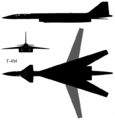Sukhoi T-4
The Sukhoi T-4, or "Aircraft 100", or "Project 100", or "Sotka" was a Soviet high-speed reconnaissance, anti-ship and strategic bomber aircraft that did not proceed beyond the prototype stage. It is sometimes called the Su-100.[1]
| T-4 | |
|---|---|
| Sukhoi Т-4 at Central Air Force Museum | |
| Role | Bomber/Reconnaissance |
| Manufacturer | Sukhoi |
| Designer | Pavel Sukhoi, Naum Chernyakov (chief designer) |
| First flight | 22 August 1972 |
| Status | project cancelled |
| Primary user | Soviet Air Force |
| Number built | 4 (only 1 passed test flights) |
Design and development
In 1963, the Soviet government held a request for proposal among the aircraft design bureaus, with the aim of developing an aircraft analogous to the North American XB-70 Valkyrie. The Sukhoi design, with its high cruise speed of 4,200 km/h (2,600 mph) was favored over the designs submitted by Yakovlev and Tupolev and after a preliminary design review in June 1964, the building of a prototype was authorized. Development of the T-4 required massive research effort to develop the technologies necessary, including the manufacturing technologies to machine and weld the materials necessary to withstand sustained Mach 3 flight. Nearly 600 patents or inventions are attributed to the program.[2] The first flying prototype was finally completed in the autumn of 1971. Work continued on an additional three airframes (one for static testing) through 1975. In 1974, the Ministry of Aviation Industry ordered work suspended on the T-4 project, which was officially scrapped on 19 December 1975.
The T-4 had intake ramps similar to the XB-70, was made largely from titanium and stainless steel, and featured a quadruple-redundant fly-by-wire control system but also employed a mechanical system as a backup. The aircraft's droop nose lowered to provide visibility during takeoff and landing. A periscope was used for forward viewing when the nose was retracted, and could be employed at speeds of up to 600 km/h (370 mph). Drogue parachutes were used in addition to conventional wheel brakes.[1]
Operational history
The first T-4, designated "101", first flew on 22 August 1972. The test pilot was Vladimir Ilyushin, son of famed aircraft designer, Sergei Ilyushin, and navigator Nikolai Alfyorov. Testing continued to 19 January 1974. The T-4 flew only ten times for a total 10 hours and 20 minutes. It is believed to have reached at least Mach 1.3 at an altitude of 12,000 m (39,000 ft) using four Kolesov RD36-41 engines. These engines each produced 16,000 kilograms-force (160 kN; 35,000 lbf) thrust with afterburners. The aircraft was designed to achieve speeds of up to Mach 3.0 with nine tons of weapons (two MKB Raduga Kh-45 missiles) under the wings, but the program was cancelled before the full performance of the aircraft could be reached. .
Aircraft on display
One T-4 survives. Aircraft "101" is on display at the Central Air Force Museum in Monino near Moscow. The serial numbers of the prototypes were "101" to "106". Only "101" and "102" were built, while other additional prototypes "103" and "104" were under construction, and "105" and "106" only existed on draft charts. Only the "101" completed all the test flights and flew the last test flight before the project was canceled on 22 January 1974. The rest of the prototypes were scrapped.
Specifications
Data from
General characteristics
- Crew: 2
- Length: 44 m (144 ft 4 in)
- Wingspan: 22 m (72 ft 2 in)
- Height: 11.2 m (36 ft 9 in)
- Wing area: 295.7 m2 (3,183 sq ft)
- Empty weight: 55,600 kg (122,577 lb)
- Gross weight: 114,000 kg (251,327 lb)
- Max takeoff weight: 135,000 kg (297,624 lb)
- Powerplant: 4 × Kolesov RD-36-41 afterburning turbofan engines, 157 kN (35,000 lbf) with afterburner
Performance
- Maximum speed: 3,200 km/h (2,000 mph, 1,700 kn)
- Maximum speed: Mach 3
- Cruise speed: 3,000 km/h (1,900 mph, 1,600 kn) / M2.8
- Ferry range: 7,000 km (4,300 mi, 3,800 nmi)
- Service ceiling: 20,000–24,000 m (66,000–79,000 ft)
Gallery
 T-4
T-4 T-4M
T-4M T4MS
T4MS
See also
Aircraft of comparable role, configuration and era
Related lists
References
External links
| Wikimedia Commons has media related to Sukhoi T-4. |